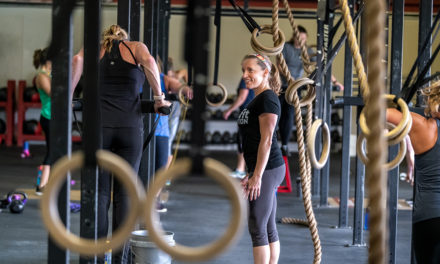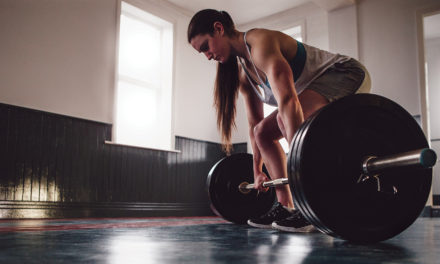A hybrid form of yoga known as sculpt is more popular than ever, but is it still yoga, and does that even matter?
In 2025, it’s fairly routine for a yogi to get encouragement from a couple of baby goats. It’s also common for a practitioner of yoga to be floating on a stand-up paddleboard on the Barnegat Bay, hovering in trikonasana. These days, yoga is taking all kinds of shapes, and new and hybrid forms seem to be emerging all the time. Goat yoga. CrossFit yoga. Aerial yoga. Laughter yoga. Hip-Hop-infused. Karma yoga. Even horseback yoga.
Since the oldest forms, like hatha yoga originated in the 15th century, the practice has continued to evolve into variations that some consider challenging and engaging, and others think are unrecognizable and frivolous. But one of the most popular variations, known as yoga sculpt, is gaining momentum, in some cases usurping more traditional forms, even in yoga studios once thought to be more committed to purist forms like vinyasa and ashtanga.
Yoga sculpt, which utilizes weights and sometimes sprinkles in bursts of cardiovascular exercise, was first introduced in 2004 when the yoga chain CorePower launched a yoga sculpt class created in response to student requests to combine the mindfulness of yoga with the strength-building benefits of weight training.
While the original sculpt format added weight training to yoga poses in something resembling a vinyasa flow (like adding weight lifting flies to a Warrior II), studios are modifying to include cardio in a more high-intensity interval focus, says Katina Magac, a yoga and fitness instructor in Bucks and Montgomery Counties, PA. “Sculpt is a combination of learning basic yoga poses with weight, but I teach some classes now where there are bursts of cardio to get that heart rate up,” she says. “I love it because it’s a great workout, but it offers some the benefits of the traditional aspects of yoga.”
Wher I’m teaching, I want you to walk into my class and feel free—there’s no judgement. I want you to do what works for you for the 60 minutes you are there. Sculpt was introduced because studios realized that life got so hectic, and society is so crazy. As much as they love the spiritual end of it, people want to get their workout in and the dose of spiritual calm all at once.


My Favorite Yoga Mat
If you’ve ever heard of a yoga mat described as “springy,” but you had no idea what that meant, the Liforme mat is the yogic equivalent of that perfect running shoe that gives you a little extra bounce in your step. In addition to gorgeous designs and sturdy grip, the Liforme mats will last a long time if you give them the proper TLC. One downside, they are pricey (between $140 and $220), but if you’ve got the budget, they are worth every penny.

I could be in a classical yoga pose, and my mind is completely elsewhere. On the other hand, I could be like lifting weights in a mindful and conscious way, where I’m using my breath and I’m feeling my feet on the floor. Which of those two is more yoga?
Hot Debate
Magac, who originally took her yoga teacher training (YTT) to help her work through a difficult time in her life, says there are yoga instructors and yogis who prefer more traditional forms of yoga, but teaching yoga, per se, was never Magac’s main goal. “Wherever I’m teaching, I want you to walk into my class and feel free—there’s no judgment. I want you to do what works for you for the 60 minutes you are there,” she explains. “Sculpt was introduced because studios realized that life got so hectic, and society is so crazy. As much as they love the spiritual end of it, people want to get their workout in and the dose of spiritual calm all at once.”
Yoga educator Sarah Ezrin, author of The Yoga of Parenting: Ten Yoga-Based Practices to Help You Stay Grounded, Connect With Your Kids, and Be Kind to Yourself, says many traditionalists miss the boat when they don’t allow for more freedom in one’s yoga practice. “I believe yoga is a way of life. It’s not a shape that you make with your body,” Ezrin says. “I could be in a classical yoga pose, like kakasana (crow), and my mind is completely elsewhere, or I’m filming myself for social media. On the other hand, I could be lifting weights in a mindful and conscious way, where I’m using my breath and I’m feeling my feet on the floor. Which of those two is more ‘yoga?’”
Not only does Ezrin condone sculpt and other alternative forms of yoga, but she says adding weight lifting to your fitness regimen is a must, especially for women.
Ezrin began teaching yoga in 2008 and has since taught classes in studios and retreats around the world. She says the addition of weights is now central to what she teaches.
“I teach a movement class, and there’ll always be weights and resistance bands and complex movements—all of that’s so important,” Ezrin says. “We are here in these physical forms, and we have to take care of our body. We have to remember that these aren’t moves that were sent down from the divine, so people should do what works for them and their bodies.”
Practice is Personal
Even within the context of a more traditional ashtanga yoga class, Ezrin encourages students to make the practice their own or even just what works for them on any given day. The rigidity of some yogic practices can actually be detrimental to one’s well-being, she says. “I’m very open about the fact that I had an eating disorder history, in part because I was so obsessed with getting my leg behind my head, and I was doing these poses that required me to be smaller and smaller,” Ezrin explains. “Yes, I was good at making and holding poses, but was that more yoga than me meditating this morning with my kids in the room and Sesame Street on in the background? Not to me.”
But even in its purest form, Ezrin reminds students that the yoga is about so much more than just a practice of moving from one pose to another. It’s about connecting with your breath and listening to your body, she says.
Listening to your body and doing what motivates you and makes your body stronger may mean taking a more hybrid form of yoga, including sculpt. “Many people do get really upset and believe it must be a certain way, but I think that is changing somewhat,” she says. “I remember that when sculpt first started, there were a lot of yoga people, these more senior teachers, who were pretty appalled, where today, I find it’s much more accepted.”
The more options there are, the more accessible yoga becomes for a wider range of people, Magac says. If lifting is important to you, but you don’t have time for yoga and weight training, sculpt is an excellent option, she says. “On the whole, I’d say yoga has become more accessible, more friendly, more joyful, and more community. It’s just a different vibe,” she says. “Now, no matter what you’re looking for, you have classes that suit everyone’s needs. If you’re looking to really want to work out, take a sculpt class. If you need to connect to your breath and stress, take a restorative class. If you want to sweat out your stress and challenge your yogic poses, take a hot yoga class. I love that there’s something for everyone.”





